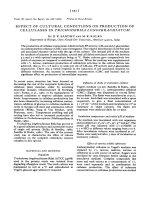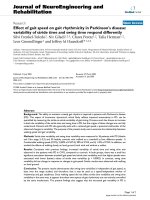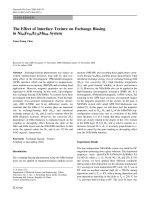Effect of surrogate advertisement on consumer response in India
Bạn đang xem bản rút gọn của tài liệu. Xem và tải ngay bản đầy đủ của tài liệu tại đây (299.51 KB, 8 trang )
International Journal of Management
Volume 11, Issue 03, March 2020, pp. 419-426. Article ID: IJM_11_03_044
Available online at />Journal Impact Factor (2020): 10.1471 (Calculated by GISI) www.jifactor.com
ISSN Print: 0976-6502 and ISSN Online: 0976-6510
© IAEME Publication
Scopus Indexed
EFFECT OF SURROGATE ADVERTISEMENT
ON CONSUMER RESPONSE IN INDIA
Abin P Jose
Assistant Professor in Commerce
St. Gregorios College, Kottarakkara, Kerala, India
Reshma Roy
Assistant Professor in Commerce
Marian College, Kuttikkanam, Kerala, India
ABSTRACT
Recently, the world has grown to be highly competitive and speedy everywhere. So,
advertising has become an integral part of modern life throughout the world. Modern
manner of advertising now causes several ethical issues in marketing trend. Surrogate
Advertising is one among the apparent trends of advertisements in advertising industry
in India. This trend is clearly helpful for the effective advertisement of many banned
products in India. As a result, the indirect advertisement of such products brings about
strong effects on consumer response. This creates the duplication of one product’s
brand image which is helpful to promote another product of same brand. For instance,
the advertisement of Bagpiper soda rings in the ears and flashes in the eyes of the
consumer the memory of the hot drink which has the same brand name. Thus, the
advertisement of the soda acts as a surrogate to liquor manufactured under the same
brand name. Here, an attempt has been made to realize the various sorts of effects on
surrogate advertisement on consumer’s perception in India.
Keywords: Surrogate Advertisement, Consumer Perception, Banned Products, Brand
Images.
Cite this Article: Abin P Jose and Reshma Roy, Effect of Surrogate Advertisement on
Consumer Response in India, International Journal of Management, 11 (3), 2020, pp.
419-426.
/>
1. INTRODUCTION
The original meaning of the word Surrogate is “Substitute”. It really does not mean ‘fake’ or
‘bogus’. This kind of advertisement occurs by manufacturing and marketing harmless products
with the brand name of harmful and alcoholic products already launched in the country. That
is, tobacco and liquor companies manufacture and market products under the same brand name
of their first harmful products. In modern world, advertising uses all types of media to propagate
/>
419
Effect of Surrogate Advertisement on Consumer Response in India
its message. The media include television, newspapers, magazines, journals along with radio,
internet, contests, posters, sponsorships, clothes, events, colours, sounds, visuals..etc. The
advertising industry consists of companies that advertise agencies that create the
advertisements, the media that carries the advertisements and a lot of people like copy editors,
visualizers, brand managers and researchers...etc. In short, it can be realized that advertisement
of any kind plays a key role in promoting a particular brand or product. However, in addition
to some positive results of advertising, it has also some negative effects on society. Such a sort
of advertising is “Surrogate Advertising”. In India, Surrogate Advertisements are used mainly
in the tobacco and liquor industry. Since, 1995, India has taken a strong stance on the
prohibition of the advertising tobacco and liquor products on all media, because such products
have adverse effects on citizen’s health. Consequently, the reputed companies were forced to
rely on alternative means of advertising which resulted in the introduction of surrogate
advertising in India. For example, now we see major liquor brands promoting their club sodas,
CDs, playing cards and mineral water...etc to cram the brand names into the heads of the
customers. For this, they make use of the support of celebrities also. Just like Bagpiper, brands
like Kingfisher and Wills employs the same techniques to draw the attention to their products.
Kingfisher has promoted everything from bottled water to soda, to calendar under the same
brand name.
2. OBJECTIVES OF THE STUDY
1. To analyse consumers awareness towards surrogate advertisements in the major states
of India.
2. To assess the influence of surrogate advertisements on consumers.
3. To realize the impact made by surrogate advertisements on consumers buying decision.
4. To learn about the awareness of consumers towards surrogate advertisements.
5. To understand whether surrogate advertisements affect in positive or negative manner
to manufacturers of banned products.
3. REVIEW OF LITERATURE
According to Prateek Maheshwari, Nitin Seth, Anoop Kumar Gupta (2014) This paper has
been reviewed accessible literature on advertisement impact regarding different advertising
media, identified major gaps in the literature and found out future research prospects in
connection with critical analysis of literature. It has been noticed that the development of the
advertisement impacts in literature from 1964 to 2013 highlights the change in the focus of
researchers from traditional to modern media. It has been recognized that different dimensions
were considered in various media for determining advertisement effectiveness which adds to
the complexities and ambiguity of the subject
In the opinion of Varalakshmi. T (2013) It is imperative to explore the positive dimensions
of surrogate advertisements & to investigate its impact on consumer buying behavior, thereby
its consequence on company’s brands and explained all aspects of surrogate advertising which
are like two sides of a coin. The trend followed by such ads could prove to be boon for big and
established players since they result in higher brand recall value, thereby helping them to push
their banned products further. Surrogate ads have proved themselves a strapping& victorious
marketing strategy for the forbidden products. Surrogate marketing at best bring huge profit to
the marketers, but leads customer to the water! Hence it’s offered a choice to the customers
whether to accept this or not.
Regarding Kirti Singh Dahiya and Kirti Miglani (2013) Relevant studies should be
conducted to analyse advertisements which were promoting the banned products to promote
through indirect advertisements. Different product categories have created and shown in the
/>
420
Abin P Jose and Reshma Roy
advertisement under the same brand name of banned to promote products. The chief aim of
these advertisements is to create brand recall of the latent product in the minds of the consumers.
Another aim of this kind of advertisement is to create brand positioning of banned products for
promoting products in the sub conscious mind of the customers. These advertisements turn
illegal into legal activities. The issue of emergence of surrogate advertisements should be
analyzed in detail.
In the opinion of Sushma C, Sharang C (2005) It is essential to evaluate whether these
advertisements were for the proposed product, or for tobacco products with same brand name.
The advertisements of plain pan masala seen on Indian television were a surrogate for the
unbanned tobacco products bearing the same name. Pan Masala came to be a recent evil habit
in India and was marketed with and without tobacco.
Regarding Sania Sareen (2013) The paper laid stress on the innovations taken by the
government to solve the issue of surrogate advertising as well how the industry negates all the
facts concerning surrogate advertising. The various methods through which this issue can be
successfully solved have also been highlighted. The new initiatives taken by industry have
promoted the products. This fact has also been shortlisted and a few case studies of the how
companies are reaping up the benefits of surrogate advertising have been discussed.
4. RESEARCH METHODOLOGY
The present study comprises primary and secondary method of data collection are used. The
primary data can be collected by using Questionnaire. The secondary data has been collected
from the available literature from Text books, Journals, Magazines, Newspapers, Annual
reports and from various websites.
4.1. History of Surrogate Advertising
It is generally believed that surrogate advertising originated in Britain. The ladies especially
married women there began protesting against liquor advertisements. Naturally, this provoked
their male folk. The protest of the house wives became so wide and vigorous that the liquor
advertising had to be banned. Unable to find no other way out the brand owners decided to
promote fruit juices and soda under the brand name of liquor. This marked the first step towards
Surrogate Advertising.
5. SURROGATE ADVERTISING IN INDIA
Almost the same development occurred in India also. Thus, the Cable T V Regulation Act
banned liquor and Cigarette Advertisements in 1995. Here also the brand owner were compelled
seek alternative ways. One example is the launching of Bacardi Blast music CD. Anyway,
several liquor companies began sponsoring and hosting glamorous items. Some others began
distributing T-Shirts, Drinking Glasses, Caps, Key chains...etc with brand names displayed on
these products. At present, tobacco and liquor ads are banned from TV and radio in India. The
print media have been allowed to display only tobacco ads with the statutory warning of
“Smoking is injurious to health”. This accelerated the surrogate ads of liquor and various
tobacco related products. The brand owners primary object is to help their brand names remain
alive in the minds of the consumers.
Advertising Standards Council of India(ASCI) took seriously a complaint against United
Breweries for an advertisement for Sand Piper Malt Beverage created by Triton
Communications. This came to be a surrogate advertising for a liquor brand. The issue took a
new turn with the Central Government deciding to ban tobacco companies from sponsoring
sports and cultural events. The same thing happened in the matter of liquor products. In addition
to a ban on smoking in public places, sale of tobacco products, liquor products to minors has
/>
421
Effect of Surrogate Advertisement on Consumer Response in India
been banned. Inspite of all these, still Surrogate Advertising cannot be checked chiefly because
the agencies including NGO’s do not have the courage enough to implement the restrictions.
The ASCI seems to feel the government has over reacted. Anyway, some social activists believe
that there is clear conflict between health and economic interests of the country.
6. LEGAL ENVIRONMENT ON SURROGATE ADVERTISING
Networks (Regulation) Act 1994 states: “ Provided that a product that uses a brand name or
logo, which is also used for Cigarettes, Tobacco Products, Wine, Alcohol, Liquor, or other
intoxicants, may advertised on cable service subject to the following conditions:
• The visuals of the advertisement should display only the product being advertised and
not the prohibited in any form or manner
• The advertisement should not make any direct or indirect hint to the prohibited products
• The advertisement should not include any manifestations or phrases promoting
prohibited products.
• The advertisement should not employ particular colours and layout or presentations
associated with prohibited products.
7. LEGAL PROCEDURES LEADING TO SURROGATE
ADVERTISEMENTS
a) Prohibition of advertisement of harmful materials
In 1995, all the advertisements about alcohol and tobacco products banned. This legal
step paved the way for the manufacturers to resort to Surrogate Advertising.
b) The restrictions imposed by Excise on Licenses
Usually, the manufacturers of Liquor items both in small scale manner and in large scale
manner are required to take license for it and register the firm. Certain other rules also have to
be obeyed by them.
c) State Government’s venture to bridle excessive trade of raw materials
Full control was imposed on the prices of the raw materials such as ethanol,
molasses...etc by both State and Central Governments
d) Development and Regulation Act 1956
Those who take up the business of manufacturing intoxicating materials were ordered
to take a license for it and also register the industry concerned.
e) Control on licensed capacity
For expansion, special license was required.
f) Various taxes and duties were required from bottling to sales stage. The amount
varying from state to state.
7.1. Prohibition in India
1. Prohibition was imposed, immediately after independence, in the state of Bombay
2. During the early part of 1970’s, a lot of rural women in different parts of the country
began to hold vehement protest against the sale of liquor in their premises. They
believed that liquor provoked their husbands to indulge in domestic violence. This was
the first large scale protest movement against liquor in India.
3. The Information and Broadcasting Ministry of India banned the advertisements of
intoxicating substances such as Liquor, Tobacco products...etc in 1995.
/>
422
Abin P Jose and Reshma Roy
4. Soon after the ban, the companies went on advertising their liquor and other substances
by means of Surrogate Advertisements.
8. DATA ANALYSIS AND INTERPRETATION
8.1. Gender
Gender
Male
Female
8.2. Age
Age
18-25
26-35
36-45
45& Above
8.3. Educational Qualification
Educational Qualification
Graduate
Post Graduate
Illiterate
/>
423
Effect of Surrogate Advertisement on Consumer Response in India
8.4. Are you conscious about the concept of Surrogate advertisement?
Agree
Neutral
Disagree
8.5. Which aspects inspired more while choosing your brand?
Peeer Group
Family
Work Place
Advertisement
Others
8.6. Are advertisements altering your impression about product?
Agree
Neutral
Disagree
/>
424
Abin P Jose and Reshma Roy
8.7. Are you purchasing a product after observing its ads?
Agree
Neutral
Disagree
8.8. In your opinion, what sorts of advertisements have great impact over banned
product?
TV
Radio
Print Media
8.9. Does a Surrogate ad prompted you to buy a particular product?
Agree
Neutral
Disagree
9. FINDINGS
i.
ii.
iii.
iv.
v.
vi.
Majority of the respondents are male ie, 80%
Many of the respondents have been found to be of the age group between 26-35 years.
80% of the respondents are Post Graduate, 15% were found to be Graduates
Many of the respondents are conscious of Surrogate Advertising
Many of the respondents prefer Advertising
88% of the respondents seem to feel advertisement alteration about product
/>
425
Effect of Surrogate Advertisement on Consumer Response in India
10. CONCLUSION
According to the thorough study, surrogate advertisements caused positive effects on consumer
responses in India. Generally, the consumers give much importance to the surrogate
advertisements coming in media especially in TV Programmes. They tend to choose their
brands depending upon the surrogate ads. Many customers heavily depend on such ads the
believe in its positive impact of helping in improvement of brand awareness and even financial
returns. To put it briefly, most of the customers are not against the surrogate ads. Eventually,
the decision to accept or reject surrogate ads lies in the hands of consumers.
REFERENCES
[1]
[2]
[3]
[4]
[5]
[6]
[7]
[8]
[9]
[10]
[11]
[12]
[13]
[14]
[15]
[16]
Maheshwari P. et. al, Advertisement Effectiveness: A Review and Research Agenda, International
Journal of Social, Education, Economics and Management Engineering Vol: 8, No: 12, 2014
Dr. V. Maheswari, A Study on Consumer Perception and Satisfaction of Water Purifier in
Kumbakonam Town, Journal of Management, 6(2), 2019, pp. 240–246
Dr .V. Antony Joe Raja, A Study on Consumer Perception in Facilities Management Among the
Middle income Public in India for Various Analytical Factors Applied in the Strategic
Management, International Journal of Intellectual Property Rights (IJIPR), Volume 5, Issue 1,
January - June (2014), pp. 01-17.
Varalakshmi .T, An Empirical study on Surrogate advertisement, The International Journal of
management, ISSN 2277-5846; Vol: 2/Issue: 1, (2013)
Gowtham Aashirwad Kumar and Dr A Ravikumar, A Study on Consumer Perception Towards
Online Ticketing Systems, International Journal of Advanced Research in Engineering and
Technology (IJARET), 11 (1), 2020, pp 110-115.
J. Chandrasekaran and Dr. M. Raja, Consumer Perception Towards Shopping Mall with Reference
to Tiruchirappalli District in Tamil Nadu, Journal of Management, 5(4), 2018, pp. 138–137.
Dahiya K.S. et. al, Emergence of Surrogate advertisement, A Journal of Economics and
Management Vol.2 Issue 10 October 2013, ISSN 2278-0629, (2013)
Jyotishman Das, Consumer Perception Towards „Online Food Ordering and Delivery Services‟:
An Empirical Study, Journal of Management, 5(5), 2018, pp. 155–163.
Dr. Rajesh Kanthe, Ms.Vaishali Pramod Pawar and Rajendra Mohite, Sale of Over the Counter
(OTC) Drugs Via Post Offices-A Consumer Perception, International Journal of Advanced
Research in Management (IJARM), Volume 3, Issue 2, July-December (2012), pp. 63-68.
Haran J. (2013) Surrogate Advertising -Hard Product and Soft Promotion: International Indexed
& Refereed Journal, March, 2013, ISSN 0974-2832 (Print), E-ISSN2320-5474, RNI RAJBIL,
2009/29954, vol –v* Issue- 50
Mr. Chintan H Rajani, A Study to Explore Scope of Direct to Consumer Advertisement (DTCA)
of Prescription Drugs in India, International Journal of Marketing and Human Resource
Management (IJMHRM), Volume 3, Issue 1, January- December (2012), pp. 19-28
Sindhushree M T, A Study on the Influence of Fairness Cream Advertisements on the Purchase
Behavior and Belief System of Youth in Mysore, International Journal of Mechanical Engineering
and Technology 9(7), 2018, pp. 496–504.
Shivesh Rajpal, Amrita Nayak, Impact of Surrogate Advertisement on Consumer Perception in
Indore City, International Journal of Engineering and Management Research, April 2015, Volume5, Issue-2, ISSN (ONLINE): 2250-0758, ISSN (PRINT): 2394-6962
Dr. Snigda Sukumar, Perception of People on the Images of Woman in Advertisements and its
Impact on the Brand, International Journal of Marketing and Human Resource Management
(IJMHRM), Volume 4, Issue 3, September - December (2013), pp. 30-37.
Kirti Ghale and Dr. D.B. Singh, Study on Advertisement, Promotion and Supplemental Aspects of
Integrated Marketing Communication, International Journal of Advanced Research in Management
(IJARM), Volume 6, Issue 1, January-April (2015), pp. 50-59.
Geetha.V, Uma L J, Veda K, Harsha E V and Thejaswini H A, Tribulations of Negative Marketing
and Fake News on Society Through Advertisement - A Conceptua Scaffold, Journal of
Management, 5(3), 2018, pp. 178–186.
/>
426









